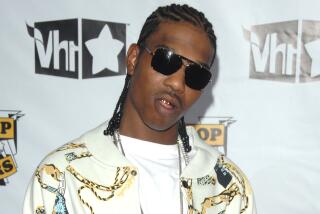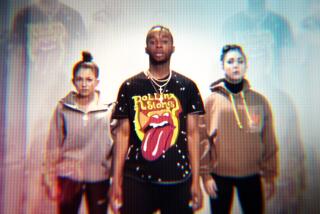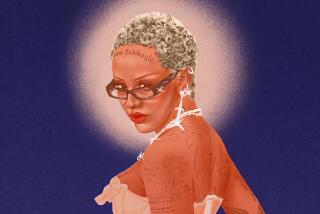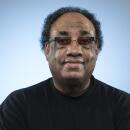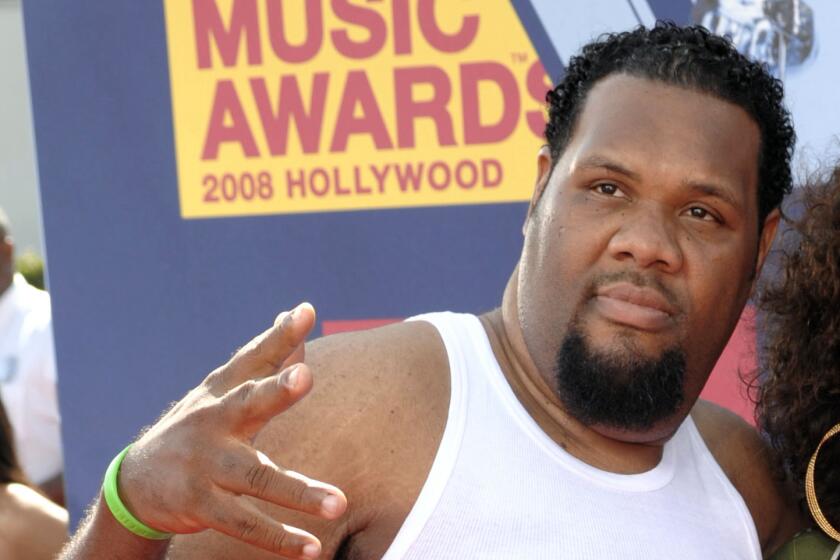Overlooked in the Rap Flap : Despite Radio Airplay Debate, ‘Gangsta’ Videos Are a Cable TV Staple
Straight out of the tube into your living room come the latest music videoz N the hood:
* In “Gangsta Lean” by DRS, four young men sing a ballad mourning the gang-related death of a “homie” while sipping 40-oz. bottles of beer and reminiscing about how they used to hang out. Toasting other dead friends and “my boys in the pen who ain’t never gonna see the street again,” one of them says, “It don’t matter what they were doing. Bangin’, slangin’. But they ain’t here no more. . . .”
* In Ultramagnetic MCs’ “Raise It Up,” another group of young men stare straight at the camera as one raps, “I’m back on the scene to pull a lesson out, even if I have to pull my black Smith & Wesson out.”
* Controversial rapper Tupac Shakur parties with friends on a hilly estate far above the inner city in “I Get Around.” Dancing bare-chested, a large “Thug Life” tattoo is visible across his torso. He later verbally blasts a woman for making sexual overtures without following through.
* A large group of young people, some with small children, gather with rapper Dr. Dre at a park for some picnicking and volleyball in “Nothin’ but a G Thang.” One of the partyers puts some ribs on a grill. Tucked in the back of his pants is a gun.
* In “Steady Dippin’,” by Bloods and Crips, a heavyset rapper casually holds a pistol in front of a graffiti-marred wall while proclaiming, “You ain’t gonna change this gangsta Crip thang. It’s plain and simple ‘cause things don’t change.” He stands in the parking lot of a small market, where a mass of young people around him flash gang signs.
The debate over the banning and editing of violent and explicit rap songs on radio stations is rapidly escalating, but little of the public outcry has been directed at three cable outlets showing rap videos. Violent “gangsta” imagery continues to be a staple on MTV, Black Entertainment Television (BET) and request-video station the Box.
Although they have not yet directly complained to the cable companies, however, police, politicians and community leaders say they are angered by the airing of several popular videos that they say show youths and young adults--predominantly African American--possessing weapons, rapping about shooting police officers, drinking large bottles of beer, smoking marijuana and generally acting in a way that glorifies and romanticizes gang lifestyles.
Members of protest groups, youth counselors and law enforcement officers say young fans of videos by Shakur, Snoop Doggy Dogg, DRS, Eazy-E, Ultramagnetic MCs, Mista Grimm and others are being influenced and attracted by the attire and behavior in the videos. Some say the clips frequently portray a negative and one-sided view of young African American life.
“These videos are sickening,” said Chilton Alphonse, director of the Community Youth Sports and Arts Foundation in South-Central Los Angeles, which helps counsel troubled youth. “On video, everyone sees all this stuff happening with a hip beat. They say they’re talking about what’s happening in the streets, but what if only a small percentage of kids have had these experiences? It just opens a whole can of worms.”
Rose Wagner, a member of the Inglewood-based grass-roots organization Stop the Violence-Increase the Peace Foundation, said her 14-year-old son Nicholas has been greatly influenced by “gangsta” videos on MTV and BET.
“I’m trying to keep him positive and respectful, but these videos and certain lyrics are wiping out all I’ve taught him for the last 14 years,” Wagner said. “I think these kind of images are really affecting the community.”
Officer Tony Newsom of the Los Angeles Police Department’s Jeopardy Program, which attempts to steer youngsters away from gang behavior, said the gangsta videos have had a noticeable effect on children. “Lot of kids will tell me, ‘Yeah, that video is cool, I like the way that dude was dressed,’ ” he said. “Lot of kids are singing lines like ‘A 187 on an undercover cop,’ rolling 40s, smoking chronic. These guys are heroes.”
*
Executives at MTV, BET and the Box defend their airing of the videos, saying they are careful to edit questionable or violent material. They insist that most of the clips do not promote violence or criminal behavior. Many of the videos with violent, gang-related imagery are actually anti-violence, they said, adding that several non-controversial and nonviolent videos by groups such as Arrested Development and A Tribe Called Quest are featured just as prominently on the stations.
John Cannelli, senior vice president of talent and music relations at MTV, said, “We haven’t banished gun videos on MTV when there is a context. The guns in Dr. Dre’s videos reflect a reality of the life he lives. The reality is, he has to be armed. Does it end up being glorification if it is a fact of his life, and the fact of many peoples lives? I don’t know if eliminating that image would change anything.”
John Robson, director of programming on the Box, said he felt the controversy was largely a fabrication of the media, and that young viewers were smart enough to distinguish music videos and real life. “A lot of this stuff is like show business to them,” he said.
“There’s one thing that all these people against ‘gangsta rap’ should realize,” said Jeff Lee, vice president of network operations and programming for BET. “These rappers didn’t invent guns, and they didn’t invent the use of guns. There’s much more violence in movies today. But black kids get labeled with starting everything bad in society.”
Still, all three cable outlets said they are aware of the controversy and are taking steps to counterbalance the violent images.
MTV recently aired a special dealing with violence among youth, “A Generation Under the Gun,” and plans an anti-violence public-service campaign early next year.
The Box, a video “jukebox” available in about 17 million homes across the country and on several local cable systems, is also initiating a “Violence Sucks” ad campaign early next year.
BET says it will cut back dramatically on videos that feature guns, not because of anyone’s protest but because other artists were not getting enough airplay.
“We want to work with the record industry, the artists and their management,” Lee said. “You will not see guns and violence in the totality that you may have seen on BET. I’m not telling these people not to make these videos. They can be my guest. But we’re going to limit how much of them we put out there.”
Local youth leaders and members of protest organizations say those steps do not go far enough, and that the three companies should follow radio stations that have taken a stand against explicit rap songs.
KPWR-FM, the most popular English-language radio station in the Los Angeles-Orange County market, announced last week that it would eliminate three derogatory words from rap songs it plays. The move was made in response to concerns by listeners and a threatened advertiser boycott.
KPWR’s decision came one day after WBLS-FM in New York City said it would ban songs that promoted violence or that had profane or hateful lyrics toward women and gays. Los Angeles station KACE-FM last month banned all music that glorified violence and denigrated women, saying it felt a moral responsibility as a black-owned station to protect its audience.
The opponents of explicit rap are not against all rap video, saying that there are often positive messages and information contained in the genre that reflects the brutal reality of the streets. They praised several rap videos, including “U.N.I.T.Y.” by Queen Latifah, which criticizes black men who use insulting terms for women; “Keep Your Head Up” by Shakur, which is a tribute to African American women; and the black humor of “Hip Hop Hooray” by Naughty by Nature, which ends with a water-rifle battle between two groups of young people.
More to Read
The biggest entertainment stories
Get our big stories about Hollywood, film, television, music, arts, culture and more right in your inbox as soon as they publish.
You may occasionally receive promotional content from the Los Angeles Times.
